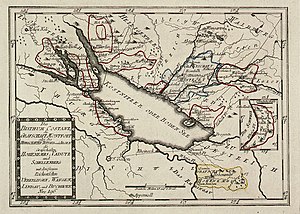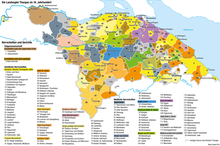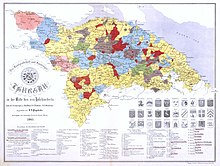Constance monastery
|
Territory in the Holy Roman Empire |
|
|---|---|
| Constance monastery | |
| coat of arms | |

|
|
| map | |

|
|
| Alternative names | Principality of Constance |
| Ruler / government | Prince-Bishop |
| Today's region / s | DE-BW , CH-TG |
| Parliament | 1 virile vote on the ecclesiastical bench in the Reichsfürstenrat |
| Reichskreis | Swabian Empire |
| District council | 1 virile vote on the spiritual bench |
| Capitals / residences | Constancy ; from 1526 Meersburg |
| Denomination / Religions | Catholic |
| Language / n | German |
| surface | 400 km² (1802) |
| Residents | 14,000 (1802) |
| Incorporated into | Secularization 1803; |
| See also | Diocese of Constance |
The Hochstift Konstanz , also known as the Prince Bishopric of Konstanz , was the secular domain of the Prince Bishops of Konstanz . In contrast to the diocese of Constance , the bishopric was fragmented and much smaller; the possessions were distributed on both sides of Lake Constance and the High Rhine . The prince-bishops failed to establish sovereignty in a large and closed territory during the Middle Ages , mainly due to the location of the bishopric between the imperial abbeys of Reichenau and St. Gallen .
history
middle Ages
A document from Emperor Frederick I from 1155 is the first confirmation of the possessions of the bishopric. Active prelates such as Bishop Eberhard von Waldburg were able to significantly increase property on both sides of Lake Constance and the Upper Rhine in the 13th century, among other things by buying back lost dominions and fiefs . In a document from 1294, the sale of Rötteln Castle with the associated towns of Tengen (today's Hohentengen ) and Kaiserstuhl by the " Barons of Regensberg to the Bishopric of Constance" is documented. Bishop Heinrich von Klingenberg had an arable land created around 1302 , which recorded the Constantine property at its peak. The main focus of ownership then remained essentially until the abolition of the principality.
Early modern age

There were no territorial losses associated with the Reformation , but the income associated with the parishes and monasteries, especially in Württemberg and in the reformed areas of the Confederation , was lost. The incorporation of the Augustinian monastery in Öhningen (1534) and the Reichenau Abbey (1540) brought a certain balance . Thanks to their possessions and rights, an almost closed domain of Constance was created on the Untersee. However, due to the location of the bishopric between the expanding Confederation, the Empire and the House of Habsburg, political leeway was severely restricted from the middle of the 15th century. The bishopric had to be relocated from the city of Constance . Meersburg on the north shore of Lake Constance became the royal seat .
The constitutional situation turned out to be difficult after the Swabian or Swiss War in 1499 led to the factual differentiation between Reichsboden and Swiss soil. The prince-bishop of Constance also owned the high court , an important element of national sovereignty : on Swiss soil until 1798 only in the cities of Arbon (including Horn ) and Bischofszell in only a few rulers . The military sovereignty, on the other hand, lay with the Federal Bailiwick of Thurgau . To distinguish it from the later acquired Reichenau goods, the Constance rulership and property rights in Thurgau , which had existed since the Middle Ages , were referred to as "old-style". In addition to numerous individual estates and churches, the Prince-Bishop of Constance retained the main manorial lower jurisdiction . In addition, he was the lord with most of the serfs in Thurgau . At the end of the 18th century, he commanded over 12,000 mostly peasant subjects throughout the prince-bishopric.
secularization
In the course of the secularization initiated by Napoleon , the prince-bishopric of Constance fell as a whole to the Margraviate of Baden in accordance with Section 5 of the Reichsdeputationshauptschluss of 1803 ; The Margrave of Baden had already taken provisional possession of the bishopric through a patent dated September 16, 1802 .
Negotiations in Schaffhausen led to the Baden-Swiss State Treaty of 1804, which transferred the constancy property on the left of the Rhine to the cantons of Zurich , Schaffhausen , St. Gallen , Aargau and Thurgau on January 1, 1805 . They compensated Baden with 440,000 guilders and set up a diocesan fund of 300,000 guilders, from which the Swiss share in the pensions of the last Prince-Bishop Karl Theodor von Dalberg and the Konstanz cathedral capitular was initially paid .
Imperial legal position
The Hochstift Konstanz had a seat and vote in the Imperial Council of Dukes . It had a virile voice there and took a seat on the prince's clerical bench. As a Catholic imperial estate, the bishopric also belonged to the Corpus Catholicorum .
In the district council of the Swabian Reichskreis the Hochstift also had a virile vote and the chairmanship of the ecclesiastical prince bank. Together with the Duke of Württemberg , the Prince-Bishop of Constance held the district advertising office, the most important office in the imperial district. The Hochstift also belonged to the committee of the district assembly (Ordinari-Deputation).
Economic basis
The farmers belonging to the bishop from the Bischofshöri , an area in the triangle Konstanz - Münsterlingen - Ottenberg TG , the local mountain of Weinfelden - Gottlieben , had to pay the bishop and his clergy in kind and interest payments.
territory
In the Holy Roman Empire
In the Swabian Empire of the Holy Roman Empire were the following areas of the secular rule of the bishopric:
- in the county of Heiligenberg ( Linzgau )
- in the Landgraviate of Nellenburg ( Hegau )
- Homburg with Stahringen
- Reign of Rosenegg (Upper Bailiwick of Bohlingen)
- Obervogteiamt Bohlingen - Gaienhofen ( Höri )
- Obervogteiamt Öhningen (Höri)
- Obervogteiamt Reichenau
Important lost possessions were the rule Küssaburg and the city of Tiengen .
In the Old Confederation
Most of the secular rule of the Bishopric of Constance lay in the area of the Old Confederation , whereby the Bishopric could nowhere exercise complete sovereignty. In the upper bailiffs of Arbon and Bischofszell, it at least achieved state sovereignty excluding military sovereignty. 1798 - in the Helvetic Republic all sovereign rights of the bishopric expired here.
In the Landgraviate of Thurgau
- Hochstiftisch-Constanz rulers, courts and fiefdoms in the Landgraviate of Thurgau
- Rulers of the old penitentiary Constance
- Upper Bailiwick of Arbon
- Obervogtei Bischofszell
- Obervogtei Güttingen
- Obervogtei Gottlieben with the Gottlieben Castle
- high fiefdom
- Hauptwil
- Reign of Zihlschlacht
- Öttlishausen
- Castle and rule Oberaach
- Fief of the cathedral monastery of Constance
- Langrickenbach
- Reign of Liebburg
- Andwil
- Wigoltingen
- Fief of the Dompropstei Konstanz
- Reign of Pfyn
- Richau or Neustift dishes
- under the Obervogt der Reichenau
- under the prince-Constance bailiff in Frauenfeld
- Rulers of the old penitentiary Constance
Regarding the old penitential Constance rule, the rule between the bishopric and the old confederation was disputed.
Cathedral chapter and Dompropstei Konstanz belonged to the court of jurisdiction in Thurgau .
In the county of Baden
The following bailiwicks of the Hochstift were in the county of Baden (later to the canton of Aargau ):
- Obervogteiamt Kaiserstuhl
- Obervogteiamt Klingnau
- Obervogteiamt Zurzach
See also
literature
- Hansmartin Schwarzmaier: Hochstift Konstanz . In: Meinrad Schaab , Hansmartin Schwarzmaier (ed.) U. a .: Handbook of Baden-Württemberg History . Volume 2: The Territories in the Old Kingdom. Edited on behalf of the Commission for Historical Regional Studies in Baden-Württemberg . Klett-Cotta, Stuttgart 1995, ISBN 3-608-91466-8 , pp. 466-480.
- Franz Xaver Bishop: The end of the diocese of Constance. Hochstift and Bishopric Constance in the field of tension between secularization and suppression (1802 / 03-1821 / 27). Stuttgart / Berlin / Cologne 1989, ISBN 3-17-010575-2 .
- M. Fleischhauer: The ecclesiastical principality of Constance at the transition to Baden . Heidelberg 1934.
- Ludger Beckmann: Bishops of Constance from the 13th to the 14th century . Freiburg im Breisgau 1995.
- Konstantin Maier: The cathedral chapter of Constance and its electoral capitulations. A contribution to the history of the monastery and diocese in modern times . Stuttgart 1990, ISBN 3-515-04362-4 .
- Rudolf Reinhardt: The Relationship of the Hochstift and Diocese of Constance to Habsburg Austria in modern times . Wiesbaden 1966.
- Andreas Bihrer : Handbook of Courtyards and Residences in the Late Medieval Empire , Volume 15.I, pp. 368–370 pdf
- Eberhard Achtermann: The holdings of the Hochstift Konstanz at the beginning of the 18th century, pp. 93-106 (scan missing) Writings of the association ... 103rd year 1985
- Franz Ludwig Baumann: The territories of the Seekreis 1800. Karlsruhe: Braun, 1894 (Badische Neujahrsblätter 4) in the Internet archive
- Hugo Hungerbühler: State and Church in Thurgau during Helvetic and Mediation 1798-1814 , Part I digitized
- Konrad Beyerle: Manorial rule and sovereign rights of the Bishop of Constance in Arbon. At the same time a contribution to the history of the German city constitution , in: Writings of the Association for the History of Lake Constance and its Surroundings , 32nd year 1903, pp. 31–116 bodenseebibliotheken.eu ; 34th year 1905, pp. 25-146 bodenseebibliotheken.eu
- Helene Hasenfratz: The Landgraviate of Thurgau before the revolution of 1798 , Frauenfeld 1908 (inaugural dissertation from the University of Zurich) in the Internet Archive
- Anneliese Müller: Hochstift Konstanz. In: Historical Atlas of Baden-Württemberg. Explanations of the epithet to map 6.8 Development of selected spiritual territories in southwest Germany by Meinrad Schaab, H.-M. Maurer, Anneliese Müller, Hans Pfeifer, pp. 12–16 Baden-Württemberg Regional Information System (LeoBW)
Web links
- Franz Xaver Bishop: Constance (Prince Diocese). In: Historical Lexicon of Switzerland .
- Discover the history of the Hochstift at Landeskunde online (LEO-BW)
- Bernhard Peter: Coat of arms of the Constance prince-bishops on www.welt-der-wappen.de
Individual evidence
- ↑ without the properties in the area of the Confederation, which were added to the Helvetic Republic as early as 1798; s. Schwarzmaier p. 479
-
↑ a b c d e f Franz Xaver Bishop: Konstanz (prince bishopric). In: Historical Lexicon of Switzerland .
These sections are largely based on the entry in the Historical Lexicon of Switzerland (HLS), which, in accordance with the HLS's usage information, is licensed under the Creative Commons - Attribution - Share Alike 4.0 International (CC BY-SA 4.0) license . - ^ WH Mayer: Home book for the district of Waldshut, Verlag A. Philipp, Waldshut (Baden) 1926, p. 211 f.
- ^ Ralf Seuffert: Constance. 2000 years of history. 2nd Edition. UVK Verlagsgesellschaft, Konstanz 2013, p. 16.
- ↑ see Baumann p. 13
- ↑ see Müller p. 15
- ^ After Helene Hasenfratz: The Landgraviate of Thurgau before the Revolution of 1798 , Frauenfeld 1908, (inaugural dissertation from the University of Zurich), pp. 68–84 in the Internet Archive



